HOW many people go to a restaurant and ask for a steak from a two-tooth animal? For years, Australian beef has been graded and described according to the number of teeth (dentition) and the sex of the animal from which it originated. That, suggests the producer-funded Meat & Livestock Australia (MLA), tells the consumer little to nothing about its likely eating quality.
“Our trading legacy for selling beef has been by dentition, that is, the number of permanent incisors an animal has, but we have worked out that dentition is not an indicator of eating quality,” says Sarah Strachan, MLA’s Meat Standards Australia (MSA) program manager.
“Trained sensory taste panels have told us this. We’ve had 115,000 consumers from 11 different countries do this and the data they’ve given us told us dentition doesn’t have impact on eating quality.”
So if dentition, the animal’s gender and even ossification (a cartilage-wasting measure) can’t predict quality, what can? And if it could be predicted, what would be the benefit if customers could buy beef based on predicted quality? Like fine wine, perhaps premium beef that delivers on quality could earn premium prices.
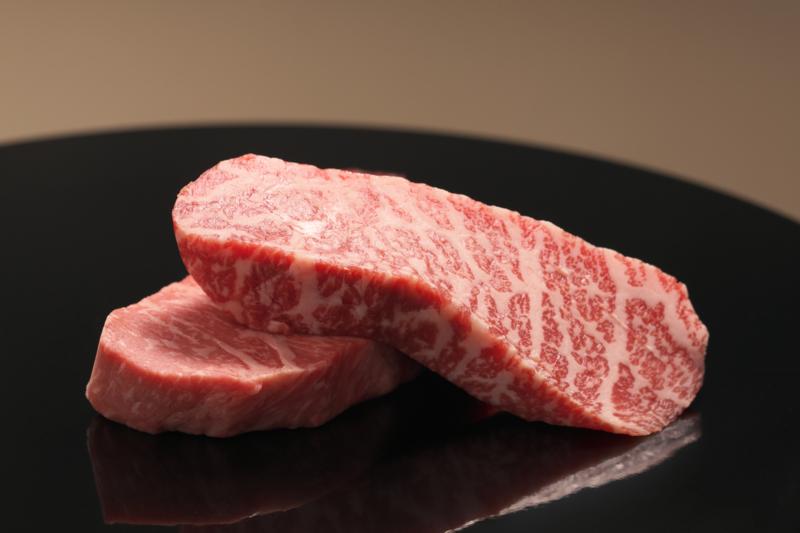 Wagyu steaks with distinctive marbling: the gold standard of beef. Source: Getty Images.
Wagyu steaks with distinctive marbling: the gold standard of beef. Source: Getty Images.
This is the thinking behind a new alternative labelling code for MSA-graded beef at processing.
The Eating Quality Graded (EQG) cipher was introduced a year ago as an alternative to dentition-based ciphers, allowing processors and brand owners to pack and sell beef based on its eating quality. It was one of 46 recommendations in a 2016 review that looked at how beef language could be made clearer for consumers.
Former feedlot owner and review co-author Dr Rod Polkinghorne says extensive consumer taste testing showed combined measures including marbling percentages, rib fat, loin temperature at the point of grading and days of ageing, along with sex, age and weight can predict eating quality for each muscle using specific cooking methods. Combined data from MSA-registered producers and processors is fed into a computer that uses complex statistical algorithms to predict consumer satisfaction.
New meat grading system already valuable
MSA says take-up of the EQG cipher has been good, and 27% of MSA-graded meat has been EQG-stamped. With 43% of the 2017-18 cattle processed nationally being MSA graded, through 41 processors, there is still a way to go. However, MSA says its grading system is already returning value – an additional $152 million last financial year, or 21c/kg more for young non-feedlot cattle and 13c/kg more for feedlot cattle than for non-MSA-graded cattle. Once the EQG cipher is fully adopted by industry, MSA estimates it could add an extra $46 million to the supply chain annually.
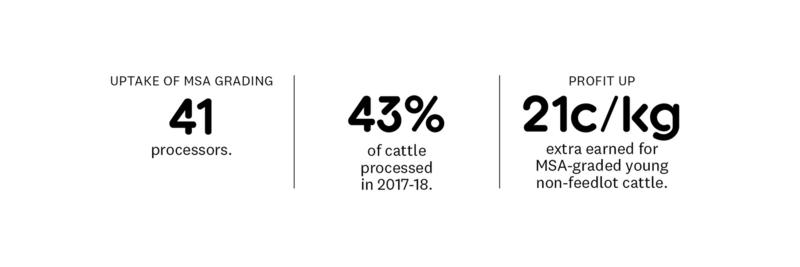
“It’s only been available since October [2017],” says Sarah Strachan. “It’s like any change or upgrade, it takes time to be accepted and for the value to be passed back to producers.”
Beef producers seizing new opportunity
Some beef farmers are seeing the new labelling as an opportunity, including top-performing NSW MSA producers the Lewis family of Bingara, in North West NSW. Jason and Ann Lewis produce beef for Coles in Sydney and Brisbane and export under their
Jac Wagyu brand to countries such as China, Korea and Indonesia. They are now planning to launch a premium brand in April.
“We’re aiming to have it EQG-stamped,” Jason says. “We’re already 100% MSA compliant and meet MSA weight gradings, but the EQG is a cipher that grades on meat quality not just age.”
“The EQG will differentiate our product from the competition in Australia and overseas.”
Careful feeding and cattle management mean the Lewises won’t need to change their systems. Their cattle are yard-weaned over two weeks and introduced to supplementary feeding gradually. Their exposure to potential stressors such as people, motorbikes and dogs is also carefully managed, and animals are not processed for transport in extreme heat or cold.
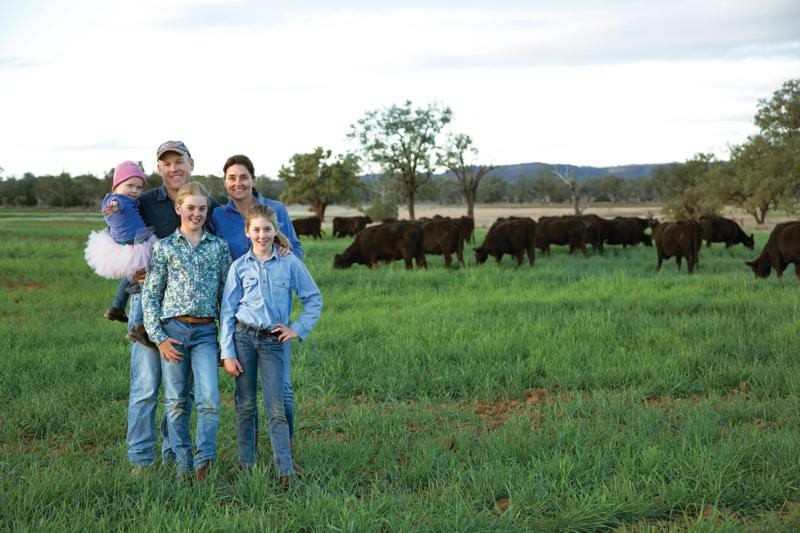 Bingara beef producers Jason and Ann Lewis with their daughters, from left, Lottie, Alex and Taylor, at their property Clevecourt. Photo by: Rachel Sherman.
Bingara beef producers Jason and Ann Lewis with their daughters, from left, Lottie, Alex and Taylor, at their property Clevecourt. Photo by: Rachel Sherman.
Jason predicts the EQG stamp will deliver good returns eventually. “It will take time for the premium pricing returns to follow through but ultimately if we can guarantee consumers will get the quality they pay for, demand will increase,” he says. “That’s when we’ll see the prices come through. It won’t have an impact overnight but it’s a step in the right direction.”
Hunter Valley cattle farmer and NSW Farmers’ Cattle Committee chair Bill Stacy warns that benefits must get back to producers. He says they must be better serviced and educated in understanding what their MSA feedback means, and what changes they need to make to deliver beef that consumers want, and that can be EQG-stamped. Producers also need accurate feedback.
“Is the full information coming back to producers and, if so, how does the producer interpret that and implement changes?” Bill says.
“There will be benefits. How long they take to get back to the producer in the form of dollars in their pockets is unknown.”
Australia’s second-largest beef processor and exporter,
Teys Australia, which processes about 18% of Australia’s cattle, agrees more work needs to be done on educating and helping producers. “The industry has done a poor job in the past of getting information to livestock producers about what consumers see as value,” says Tom Maguire, chief value chain officer of Teys.
RELATED ARTICLES ON BEEF:
-
Reaping the rewards of biodynamic farming
-
160 years of farming with Booroomooka Beef
-
From paddock to Asia
“We are transforming all our systems so producers get feedback about what the consumer thinks is good. We have it about 30% right – but we are making great strides in the right direction.”
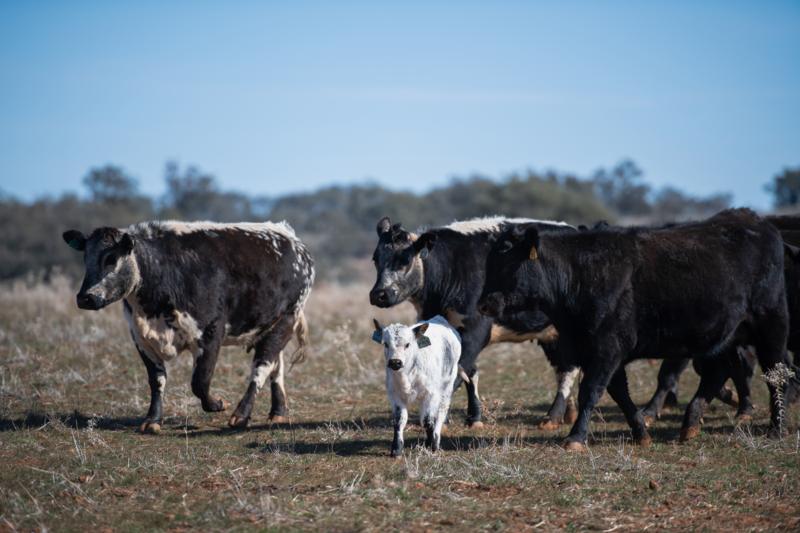 Good quality Angus beef, like these cattle from JAD Agriculture, is in high demand from customers. Photo by: Pip Farquharson.
Good quality Angus beef, like these cattle from JAD Agriculture, is in high demand from customers. Photo by: Pip Farquharson.
Changing how beef is described, labelled and sold, so consumers understand what eating quality their dollar buys is a good move, Tom says. “We know if we deliver to consumers more of what they want, they will pay more,” he says.
The ability to promise and deliver on eating quality will be vital for the Australian beef industry’s future, he believes. “There are lower-cost producers around the world, like South America for example, and Australia is a high-cost producer, so we can’t compete on cost,” Tom says. “What we have to do is market our product on quality. This allows us to do that.”
High-tech meat grading gadgets
Hand-held and stationary gadgets are being developed, tested and in some cases, commercially used to grade carcases at abattoirs around Australia and internationally. “These technologies do not predict eating quality outright,” says Richard Apps, who manages MLA’s co-innovation and objective measurement program. “They are measuring attributes which can reliably predict quality.” These new technologies include high-definition and hyperspectral cameras and X-ray scanning.
- DEXA
Dual energy X-ray absorptiometry (DEXA) measures bone mineral density and has been adapted to indicate carcase yield in the meat processing sector. It locates bones in a carcase and uses this information to instruct a cutting machine to cut according to desired leanness. “It sees where the bones are and tells the saw where to cut,” Richard says. “It also tells us what proportion of the carcase is lean meat and that tells us how much sellable product is in a carcase.”

DEXA locates bones in a carcase and uses this information to instruct a cutting machine to cut according to desired leanness. Source: Beef Central.
- MIJ GRADING CAMERA
The Meat Image Japan (MIJ) grading camera (pictured above) is specifically calibrated to measure marbling. The Australian Wagyu Association is in the process of introducing the technology into Wagyu supply chains here and was aiming to have 10 cameras in use by the end of last year.
- RIB EYE CAMERA
German company E+V Technology’s rib eye camera takes a picture of the cut surface of the eye muscle and measures muscle area and marble score. The stationary device, which needs to sit at a processing grading station, is in commercial use in the United States and is being tested in Australia.
- MEQ PROBE
A South Australian start-up has developed the Meat Eating Quality (MEQ) probe, a hand-held imaging device with four needles (pictured right), designed to be pushed into the muscles of uncut carcases. It is being tested by meat processor Teys Australia for its capacity to measure and grade intra-muscular fat.
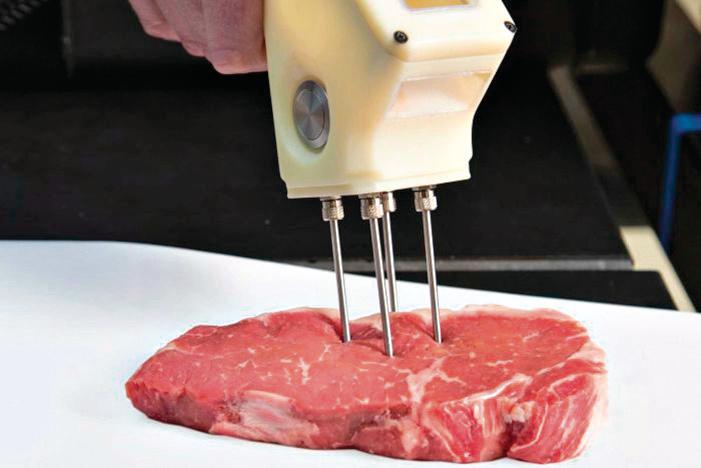
The MEQ probe measures and grades intramuscular fat. Source: Beef Central.
- HYPERSPECTRAL IMAGING
Hyperspectral cameras detect light beyond the normal visual range allowing them to look at not only the cut surface but also the muscle tissue below. Danish company Frontmatec is working on using hyperspectral camera technology combined with smart software to predict intra-muscular fat.